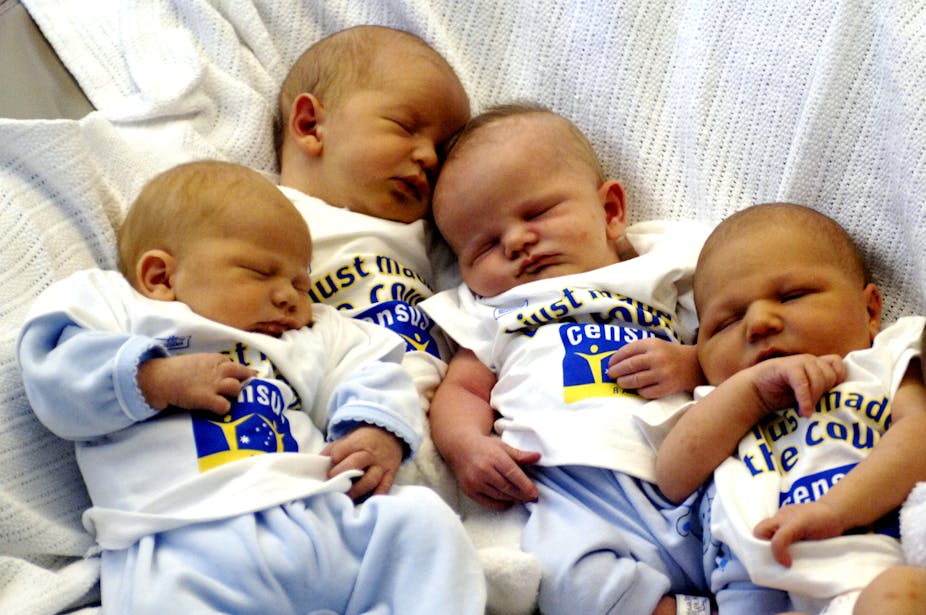With Australia experiencing declining fertility rates over the past four decades, governmental concern has increased over the consequences of the falling birth rate and how the trend might be reversed (or stabilised).
Projections from the Australian Bureau of Statistics (ABS) released recently suggest the downward trend in fertility is set to continue. According to the “medium growth” scenario, Australia’s total fertility rate (TFR) – the number of children born per woman – is projected to decline to 1.8 by 2026, down from the current level of 1.93 (in 2012). This is well below the level required for population replacement (2.1 births per woman).
There is a factor missing from this debate, lost amidst politicking over paid parental leave (PPL) and associated policy incentives: intended family size. Very few are questioning how many children Australians actually want to have? More importantly, are Australians achieving their childbearing goals?
These questions seem the logical starting point for any development of policy intended to increase births, and yet have been largely overlooked.
Background to fertility rates
There are many implications of long-term sustained fertility below replacement level. Together with increased life expectancy, this serves to further exacerbate Australia’s already (structurally) ageing population. The proportion of Australians aged over 65 years old is set to increase from the current 14% of the population to 22% by 2061.
As a result of this problematic demographic context, Australia has arguably become a country where reproduction is promoted. A range of family friendly policies have been implemented with the aim of increasing the birth rate and encouraging population growth. Most recently, the Coalition government’s pro-growth attitude was expressed when outlining its PPL scheme.
However, research has repeatedly demonstrated that cash incentives do little to drive up fertility. This is primarily because they fail to address the long-term (financial and opportunity) costs associated with childbearing.
Recent numbers
The Household, Income and Labour Dynamics in Australia (HILDA) survey collects data annually on Australians’ childbearing plans. The 2011 – and most recent – release shows that men and women in key childbearing ages (20-49 years and 20-44 years respectively) intend, on average, to have family sizes of 2.08 and 2.25 children respectively.
Notably, for the previous decade, men have consistently intended smaller family sizes than women at levels less than that required for population replacement.
When compared to the TFR (1.93), a “gap” between intended and achieved fertility for both men and women is evident. This gap is well documented in other developed countries such as Britain, and is used as a window of opportunity for policy to increase fertility.
However, the TFR as a measurement of fertility has several limitations. A more accurate measure of whether Australians are achieving their childbearing goals is to examine the gap between intended family size and completed family size.
As shown in the graph below, in 2011, for Australian women aged 40-44 years, their completed current family size (2.16) actually exceeds their intended family size (2.05). The situation is similar across Victoria, Queensland, Western Australia and Tasmania. Similar patterns are also observed for men.

Put simply, the current cohort of Australians nearing the completion of their reproductive lives have actually achieved (or exceeded) their childbearing goals. They also did so during a time when far less governmental support was available for those having children.
What does it all mean for Australia?
There is an important qualification to this overall story. In the majority of states – and in Australia as a whole – completed family size exceeds childbearing intentions primarily when family size intentions are below replacement level. Because of the changing nature of the reproductive life course, Australians revise down their childbearing intentions to better match reality (their current family size) as they age.
But what about those younger (25-29 year old) Australians at the beginning of their childbearing years? Can they be expected to meet their childbearing goals to the same extent as their predecessors?
These groups report intentions for slightly larger family sizes than their older counterparts did at their age roughly ten years ago. But given the continued downward trend in fertility levels, coupled with difficult economic times and increasing time spent in formal education, it is unlikely that future cohorts will achieve their childbearing goals in the same ways the current cohort has.
It is equally unlikely that access to a paid parental leave scheme will alter this, based on Australian and international examples of similar schemes. As demographer Nick Parr noted in The Conversation:
…the fertility of Australian women whose workplace entitlements include access to paid employer-funded parental leave differs little from that of women without access to such leave.
However, this is not to suggest that this policy (and others like it) should be abandoned.
Under the government’s PPL scheme, Australia will be brought into line with the vast majority of other developed OECD countries that pay parental leave at replacement-level wages (including superannuation). Policies that support Australians in having children and (initially) alleviate some of the financial burden associated with bearing and rearing them are of national importance and in the country’s best interests.
However, if it is the aim of the government to increase the birth rate, effective policies that address the long-term costs – both financial and opportunity costs – of having children are needed.

